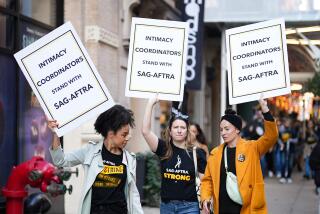Hollywood’s two main actors unions reach tentative deal to merge
After a marathon meeting, Hollywood’s two main actors unions took a historic step toward creating the largest and potentially most powerful entertainment union in the industry.
Leaders of the 125,000-member Screen Actors Guild and the American Federation of Television and Radio Artists, which has about 70,000 members, reached a merger agreement Monday after nine days of intensive talks at the Renaissance Hollywood Hotel.
If approved as expected by the union boards and memberships, the merger would end a decades-long competition between the two groups to organize actors.
The tentative pact is seen as a victory for moderates in both unions, who began merger talks nearly two years ago. That could portend a period of less-volatile labor relations in Hollywood, but, analysts say, it also could give the unions more clout by presenting a unified front in contract negotiations with the major studios — and the powerful media conglomerates that own them.
“Like any marriage, there is no guarantee that things go happily ever after when unions merge,” said Dan Mitchell, a professor emeritus and labor expert at UCLA. But, he added, if the two unions are able to integrate their decision-making process, it could lead to a labor force that is more stable and more effective.
The combination would bring a wide variety of performers — from Sandra Bullock to Vin Scully — into a single bargaining unit. SAG represents actors and extras in movies and television shows. AFTRA, which had its beginnings in radio and dominates the cable television industry, represents not just actors but also singers, dancers, disc jockeys, sports announcers, comedians and broadcast journalists, among others. About 40,000 people hold membership in both unions.
The proposed merger comes at a volatile time in the entertainment industry. The major film studios, under pressure from their corporate owners to increase profits, are being battered by shrinking box-office receipts and declining DVD sales. As a result, they are cutting back on the number of films they release and are trying to rein in production costs.
An expanding number of television channels and the growth of entertainment on the Internet has created more opportunities for actors. But cable television and Web-based shows generally pay less and produce fewer episodes than programs on the broadcast networks. The result is that, although major stars still pull in huge salaries, many middle-class actors — the bulk of the unions’ members — have been struggling.
A central question facing the unions has been how to respond to this upheaval in the entertainment market. The acting community has been bitterly divided in recent years between those, particularly in SAG, who favored hard bargaining and militancy and others who believed in a more moderate and unified approach.
In 2008, with hard-liners leading SAG, the union’s top brass engaged in a lengthy standoff with the studios and threatened a strike. Meanwhile, AFTRA suspended a longtime joint bargaining agreement with SAG and reached a separate prime-time TV contract with producers.
The split severely weakened SAG’s negotiating leverage and allowed producers to pit one union against the other. SAG lost its traditional dominance in prime-time television as producers swung most of their contracts for new shows to AFTRA, which was seen as the more stable and friendly union. The turmoil led to the ouster of the SAG leadership in 2009 elections by a moderate coalition led by veteran actor Ken Howard, who ran on a pledge to merge with the smaller sister union.
“What we have accomplished over the last year is tremendously gratifying,” Howard and AFTRA President Roberta Reardon said in a statement Monday. “We are confident that our members will agree that we have created something we can all be proud of — actors, singers, broadcasters, dancers, voice-over artists, background actors, stunt persons and all entertainment and media professionals that will be represented by this new union.”
But former SAG President Alan Rosenberg, a longtime critic of AFTRA, said the merger plan would weaken the position of all performers. “There is no way this is going to be good for actors,” he said. “The intention is not to be strong in negotiations. The intention is to silence whatever progressives remain within SAG.”
Neither union would disclose details of the agreement, but people familiar with the matter said it contains a proposed constitution, governance structure and dues-payment plan. Details of how to combine the unions’ health and pension plans would be worked out after the merger is finalized, the sources said.
SAG’s and AFTRA’s respective boards are expected to endorse the merger document this month, before it is sent to members for a ratification vote in the spring. The merger would take effect only if at least 60% of those who vote endorsed the plan.
Two earlier merger attempts, in 1999 and 2003, failed. The 2003 effort, however, barely fell short: 58% of SAG members who voted endorsed it. AFTRA members voted 76% in favor of the combination.
Unlike in 2003, however, no significant opposition campaign has appeared. One reason is that actors who belong to both unions have complained that it has become increasingly difficult to qualify for health and pension benefits when their income is split between two unions.
Even critics such as Rosenberg acknowledge that there is strong support for consolidation of the unions. “Of course it’s going to pass because the membership has been thoroughly misled,” Rosenberg said.
The Alliance of Motion Picture and Television Producers, which negotiates on behalf of the major film and TV companies, declined to comment.
The new union will be called SAG-AFTRA.
More to Read
Inside the business of entertainment
The Wide Shot brings you news, analysis and insights on everything from streaming wars to production — and what it all means for the future.
You may occasionally receive promotional content from the Los Angeles Times.











